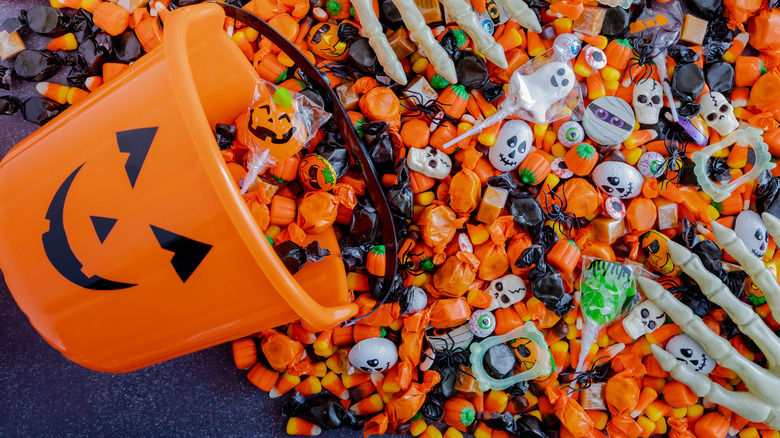The Reason Halloween Candy Sales Dropped Up To 50% In 1982
In America, Halloween is about two things: the costumes and the candy, but most children are likely in agreement that candy is the number one priority, and the costume is just the vehicle to make it happen. Of course, it's always been up to the grown-ups to make these kids' sugar wishes come true. According to Investopedia, Americans are projected to spend just over $3 billion on Halloween candy in 2022. This doesn't come as a surprise, because the last thing adults want to be known for is running out of candy (or handing out toothbrushes), so they tend to stick with the motto that it's better to have more than not enough. Plus, everyone knows the leftover Halloween candy will get eaten behind closed doors with gusto.
Unfortunately, like the playground bully, someone always seems to come along and ruin all the fun. In 1970, the New York Times reported a growing number of cases in which Halloween treats, like apples, had been implanted with razor blades or needles, although CNN notes that two incidents were unconfirmed. No doubt, guardians close to these alleged incidents at the time took a more proactive role in their kid's Halloween candy in the following years, but 12 years later, a Halloween scare swept the nation to a much greater degree.
More tricks than treats
In the days before Halloween in 1982, seven people in the Chicago area died, including a 12-year old girl, due to ingesting Tylenol that was later found to be laced with cyanide, according to Syracuse.com. Once this story hit the news, a sickening stream of copycats began sweeping the country, only this time, tainting food. Things like caramel apples and candy bars were found with sharp objects in them.
Because Halloween was coming up, concerned citizens immediately had their guard up in concern for their children. Some towns canceled trick or treating altogether, instead hosting Halloween parties where people would be certain that strangers would be providing no food or drink to their loved ones. Halloween candy sales ended up dropping that year anywhere from 20% to 50%, according to CNN.
In the towns that decided to go ahead with trick or treating, there was an increased presence of patrolling police officers, and many neighborhoods organized their own watch groups. It was recommended that parents inspect all candy their children brought home. Out of fear of being falsely accused of tainting candy, many people opted not to give out edibles at all, opting instead for things like gift certificates and money. Despite the hubbub, a 1985 study in published in Social Problems (via CNN) showed that no child was seriously harmed or killed by Halloween candy in 1982, suggesting that the fear was exaggerated, although completely understandable due to the circumstances.

